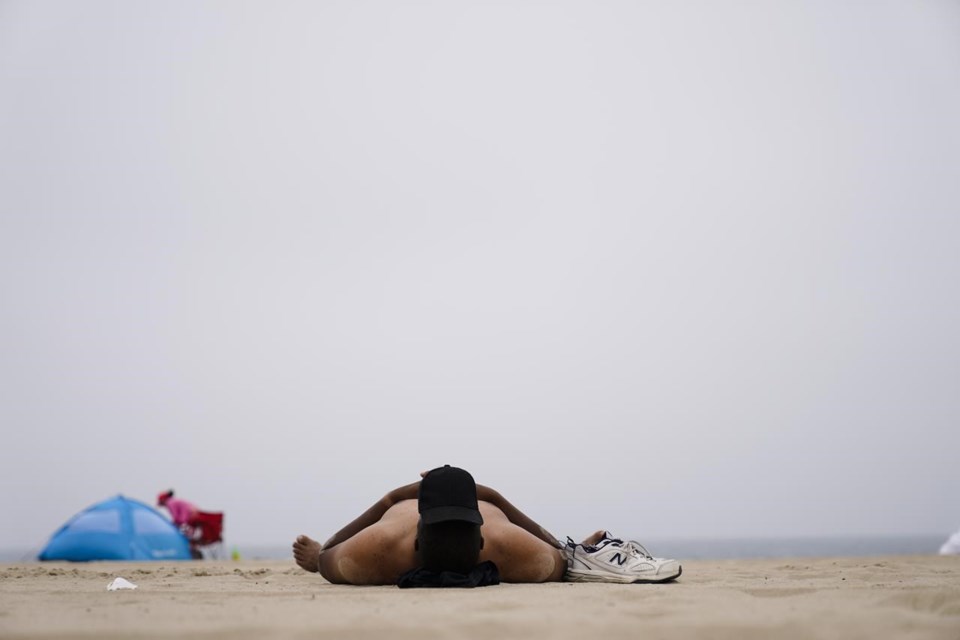PHOENIX (AP) — Even Southwestern desert residents accustomed to scorching summers are feeling the grip of an extreme heat wave smacking Arizona, Nevada, New Mexico and Southern California this week with 100-degree-plus temps and excessive heat warnings.
To add insult to injury, the region has been left high and dry with no monsoon activity, which can help offset the blazing temperatures. In Arizona, the monsoon season officially begins June 15 and can bring powerful storms with high winds, lightning and heavy bursts of rain.
The heat has made parts of Phoenix feel like a ghost town. Sunset concerts were canceled, and covered restaurant patios equipped with cooling misters sit empty.
On Monday, Martin Brown and his black Labrador, Sammy, escaped the heat in Phoenix by going to the lobby of Circle the City, an air-conditioned walk-in health clinic for homeless people that is also a designated hydration station. Anyone can come in to sit, to get bottled water, and to find snacks like a burrito or ramen.
“We’re homeless, so we don’t have a choice. Well, we have a choice: We can sit at the park and swelter in the heat, but no thank you. This is much better,” Brown said.
He spends five days a week at the center during business hours to escape the “jungle hot” time of day outside. He then takes the bus back to the park at night.
In recent years, Phoenix has taken various actions to limit risks for heat-related illness. When the National Weather Service issues an excessive heat warning, three of the city's most popular hiking trails close from 11 a.m. to 5 p.m.
In 2016, officials voted to ban hiking with dogs on trails when the temperature exceeds 100 degrees Fahrenheit (38 degrees Celsius). City park rangers oversee enforcement and citations for violations, said Adam Waltz, a city spokesperson.
On Tuesday, Phoenix reached 110 degrees F (43 degrees C) for the 12th consecutive day, according to the National Weather Service. The longest recorded stretch so far was 18 days in 1974.
The high pressure needed to generate monsoon storms just isn't in the right position, according to state climatologist Dr. Erinanne Saffell, so metro Phoenix is left with below normal precipitation levels and dry conditions that facilitate hotter temperatures. Also, some experts believe this year's heavier snowpack in the West took more energy to melt, prolonging the progression of a high-pressure system this summer.
“It just kind of delayed everything,” Saffell said.
Stepping outside is like walking into a giant hair dryer. Accidentally brushing metal and other surfaces can feel like touching a hot stove.
All the concrete and pavement in sprawling Phoenix contributes to the misery, as sidewalks and buildings bake all day and release accumulated heat slowly overnight. During the current wave, the temp isn't dipping below 90 degrees F (32 C). This cycle makes Phoenix an urban heat island.
“Phoenix in the early 1900s would average about five days a year where they had 110 degrees or higher. Now you count the last 10 years, it's about 27 days a year. That's five times more,” Saffell said.
The city is in its third year of implementing a Cool Pavement program. Pavement that reflects heat and sunlight has been installed on over 100 miles (161 kilometers) of asphalt. The new surface is supposed to lower ground temperature.
Las Vegas could also see the mercury reach between 110 and 115 degrees F (43 and 46 C) this weekend, according to the National Weather Service. In Albuquerque, New Mexico, temperatures were forecast to be between 100 and 103 F (38 and 39 C) on Tuesday with a heat advisory in effect all day. Inland areas of Southern California are predicted to see conditions peak between 100 and 113 F (38 and 45 C) from Friday through Sunday.
Every summer, libraries, churches and other facilities in Phoenix serve as cooling centers or hydration stations for those who need refuge.
Isaiah Castellanos spent Monday morning inside the city library's downtown branch and planned to return after grabbing lunch. A liver transplant recipient, Castellanos said his medications make him sunburn easily. He can't afford to go to the movies or to a museum, so the free public library is his go-to place to escape his home, which doesn't have strong air conditioning.
“It's quiet. I'll turn on my music and read a book or watch YouTube with my headphones, but also stay cool,” Castellanos said.
Melody Santiago, who oversees the front office of the Circle the City clinic, said some people are so grateful they return with thank-you cards or cookies. She is certain more people will come into the center over the next week.
“It's getting really hot, and they have nowhere else to go,” Santiago said. “It's an eye-opener: You never know, you could be there too.”
Terry Tang, The Associated Press



